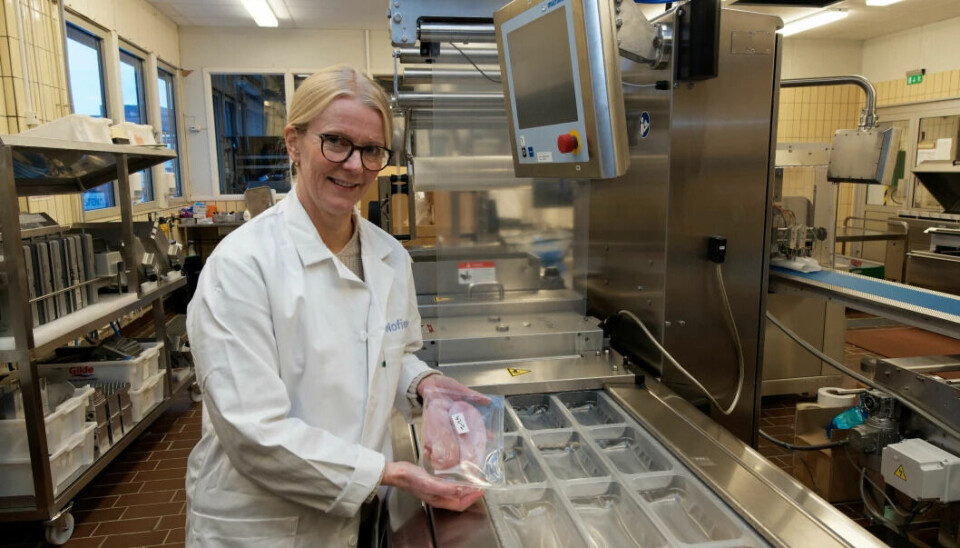THIS ARTICLE/PRESS RELEASE IS PAID FOR AND PRESENTED BY Nofima The Norwegian Institute of Food, Fisheries and Aquaculture Research - read more

Chicken fillets packed with CO₂ gas could reduce bad odour
Chicken fillets keep longer when packed with CO₂ gas. The gas causes certain types of bacteria to grow poorly, while others don’t taste and smell as bad.
More chicken fillets that can be used in tasty meals – and fewer that have to be thrown away because they have started to smell and taste bad. These are the results of the research conducted by Anlaug Ådland Hansen and her colleagues at Nofima.
The researchers have found out not only which bacteria cause the chicken to turn bad, but also what kind of odour they create.
Want to prevent food waste
“We have looked at how packaging can best protect food in order to maintain good quality and thus prevent food waste,” Hansen says.
Skinless chicken fillet is a popular food product in Norway.
“There are various bacteria that limit the shelf life of chicken fillets. The increased knowledge means that we can control the quality to a greater extent. We want all food that is produced to be eaten,” she says.
Six common bacteria
The researchers at Nofima have looked at six different bacteria that are commonly found on meat and that can also be found on fish.
“In Norway, we pack this type of fillet product either with or without bacteria-inhibiting CO₂ gas. We have added these bacteria to the chicken and then stored it with and without CO₂,” Hansen explains.
The chicken that has been tested was stored at refrigerator temperature – four degrees Celsius.
In addition to analysing the bacteria, she has received the help of professional noses to assess the quality of the chicken fillets.
Nofima has its own sensory panel consisting of 10 judges who are trained to assess smell and taste. In this case, they have smelled and determined when the meat smells, for example, sour, fermented, pungent or rotten.
“What we saw is that all the types of bacteria grew when there was no CO₂ in the packaging,” she says.
With CO₂, however, two of the bacteria did not multiply, while two others behaved the same as without CO₂ in the packaging.
Growth and odour
“Packing food without CO₂ quickly results in poorer quality than packing food with CO₂. We saw that when we packed using CO₂, only two of these six bacteria produced a clear negative odour at a certain bacterial level," Hansen says.
The researchers already knew that CO₂ inhibits bacterial growth.
"What is new here is that the gas not only extends shelf life because it results in lower bacterial growth, but we also see that the prevalence and intensity of the negative odour is reduced,” she says.
In other words: Two of the bacteria multiply just as much as they normally do, but they do not produce as much bad odour.
“We need more knowledge about what actually limits shelf life. Many studies have been conducted that are similar to this one, but none of them study individual bacteria and the different odour characteristics they produce,” she says.
Identifying what smells bad
Previous studies have shown which bacteria are found on meat when its shelf life expires. However, they have not shown which bacteria have caused the meat to smell bad.
“We have now conducted a controlled study that gives us a better insight. We know which bacteria are able to grow under different packaging conditions, which ones produce negative odours and quality, and which ones we must try to prevent through various measures,” Hansen states.
The majority of food waste occurs at home in our kitchens. Food is kept in the fridge until it expires.
“Better control of quality and shelf life is very important if we are to achieve the goals of reducing food waste. All measures that help consumers to have the best possible product quality are very useful. This could also have a major impact on food waste in stores,” Anlaug Ådland Hansen says.
Reference:
Hansen et al. CO2 packaging increases shelf life through reduction of off-odor production by CO2 tolerant bacteria in addition to growth inhibition of the spoilage bacteriota, Food Control, vol. 144, 2023. DOI: 10.1016/j.foodcont.2022.109390

This article/press release is paid for and presented by Nofima The Norwegian Institute of Food, Fisheries and Aquaculture Research
This content is created by Nofima's communication staff, who use this platform to communicate science and share results from research with the public. Nofima is one of more than 80 owners of ScienceNorway.no. Read more here.
See more content from Nofima:
-
Red algae grown in wastewater from fish-farming facilities could become sustainable salmon feed
-
Pumpkins are good for more than just Halloween decorations
-
This is how temperature affects a salmon's health and growth
-
Study: Omega-3 and zinc is a powerful duo for salmon
-
Fish may turn yellow if frozen too fresh
-
Is it better if food is packaged in plastic or paperboard?





































